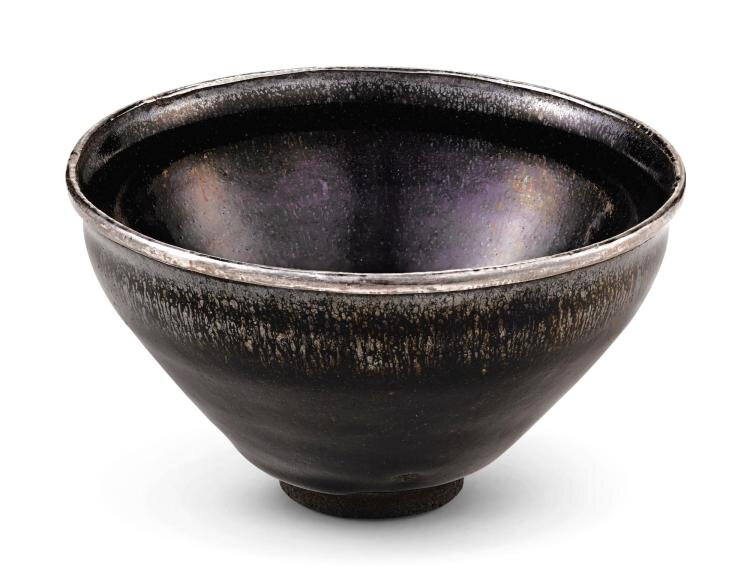A rare 'Jian' 'Hare's fur' temmoku bowl, Song dynasty (960-1279)
Lot 59. A rare 'Jian' 'Hare's fur' temmoku bowl, Song dynasty (960-1279); 12.4 cm, 4 7/8 in. Estimate 40,000 — 60,000 GBP. Lot Sold 106,250 GBP. Courtesy Sotheby's 2018.
of deep conical form with a groove below the lip and a shallow straight foot, covered in a thick black lustrous glaze, the interior with silver striations, the exterior with brown striations at the rim terminating in silvery-blue striations where the glaze pools short of the unglazed foot revealing the dark brown body underneath, the rim mounted in metal, Japanese wood box. Quantité: 2.
Black tea bowls were particularly appreciated in Buddhist monasteries, where tea was drunk for its beneficial effects on body and mind as well as ritually offered to the Buddha. The seemingly humble aspect of black tea bowls made them particularly appropriate in this context. The groove below the rim made them comfortable to hold; their heavy potting had an insulating effect, keeping the tea inside hot while protecting the fingers outside from the heat, and their dark interiors made for a striking contrast with the white froth of whipped tea.
The love and connoisseurship of black-glazed tea bowls from Fujian is intimately connected with the homage paid to these ceramics by Japanese collectors and tea masters. Temmoku tea bowls were probably brought to Japan together with Fujian tea by Buddhist monks visiting Chinese monasteries in the Song dynasty. Such bowls were revered virtually from the moment they left the kilns in the Song dynasty (960-1279). In Japan, black ‘Jian’ tea bowls became associated with monasteries in the Tianmu (Japanese: Temmoku) mountain range in Lin’an county, north Zhejiang province, now a nature reserve renowned for its giant ancient Japanese cedar trees. The Japanese term temmoku (or tenmoku) is now universally accepted for this group of black-glazed bowls, as lasting testimony of this reverence.
Hare’s fur tea bowls of the striking quality of the present bowl are rare, and it is related to a small number of prestigious 'Jian' ware tea bowls, despite variations in colour or streaks of their hare’s fur pattern; for example see one, also with a metal rim mount, included in the exhibition Karamono tenmoku. Fukken shō Kenyō shutsudo tenmoku to Nihon densei no tenmoku. [Chinese tenmoku. Excavated examples from Fujian and heirloom works from Japan], Chadō Shiryōkan, Kyoto, and MOA Art Museum, Atami, 1994, cat. no. 6; and another of much lower proportions, from the Tokugawa Art Museum, Nagoya, ibid., cat. no. 16. This exhibition catalogue, where a few important heirloom tenmoku tea bowls preserved in Japan were juxtaposed with a large sample of excavated sherds from the kiln site, impressively documents the wide range of qualities and the excellence and rarity of the examples collected in Japan. Compare also the famous nogime tenmoku bowl sold in these rooms, 11th May 2011, lot 7; the exquisite bowl from the collections of Mikyōdō (ca. 1615-1690) and Fujita Tokujiro, sold in these rooms, 9th November 2016, lot 108; and another bowl without metal rim from the collection of the Metropolitan Museum of Art, New York, included in the Harvard University exhibition, 1996, illustrated in Mowry, op.cit., cat. no. 83.
A magnificent and extremely rare 'nogime temmoku' tea bowl, Southern Song dynasty, 12th century; 12.5cm., 4 7/8 in., the stand 16.9cm., 6 1/2 in. Sold for 1,105,250 GBP to an Asian Trade at Sotheby's London, 11th May 2011, lot 7. Photo Sotheby's 2011
Cf. my post: A magnificent and extremely rare 'nogime temmoku' tea bowl. Southern Song dynasty, 12th century
An exquisite and rare 'Jian' 'hare's fur' 'tenmoku' bowl, Southern Song dynasty (1127–1279), from the collections of Mikyōdō (ca. 1615-1690) and Fujita Tokujiro; 12.2 cm, 4 7/8 in. Sold for 1,085,000 GBP at Sotheby's London, 9th November 2016, lot 108. Photo: Sotheby's 2016
Cf. my post: An exquisite and rare 'Jian' 'hare's fur' 'tenmoku' bowl, Southern Song dynasty (1127–1279)
Sotheby's. Important Chinese Art, London, 16 may 2018, 10:30 AM

/https%3A%2F%2Fprofilepics.canalblog.com%2Fprofilepics%2F1%2F0%2F100183.jpg)
/https%3A%2F%2Fstorage.canalblog.com%2F03%2F02%2F119589%2F96711876_o.jpg)
/https%3A%2F%2Fstorage.canalblog.com%2F11%2F31%2F119589%2F94773502_o.jpg)
/https%3A%2F%2Fstorage.canalblog.com%2F20%2F83%2F119589%2F94772815_o.jpg)
/https%3A%2F%2Fstorage.canalblog.com%2F26%2F72%2F119589%2F75604929_o.jpg)
/https%3A%2F%2Fstorage.canalblog.com%2F59%2F60%2F119589%2F26458628_o.jpg)






/image%2F1371349%2F20240410%2Fob_c3c107_2024-nyr-22642-0907-000-a-jian-hares-f.jpg)
/image%2F1371349%2F20240318%2Fob_fe582a_z1.png)
/http%3A%2F%2Fstorage.canalblog.com%2F85%2F73%2F119589%2F129551602_o.jpg)
/http%3A%2F%2Fstorage.canalblog.com%2F90%2F08%2F119589%2F129262970_o.png)